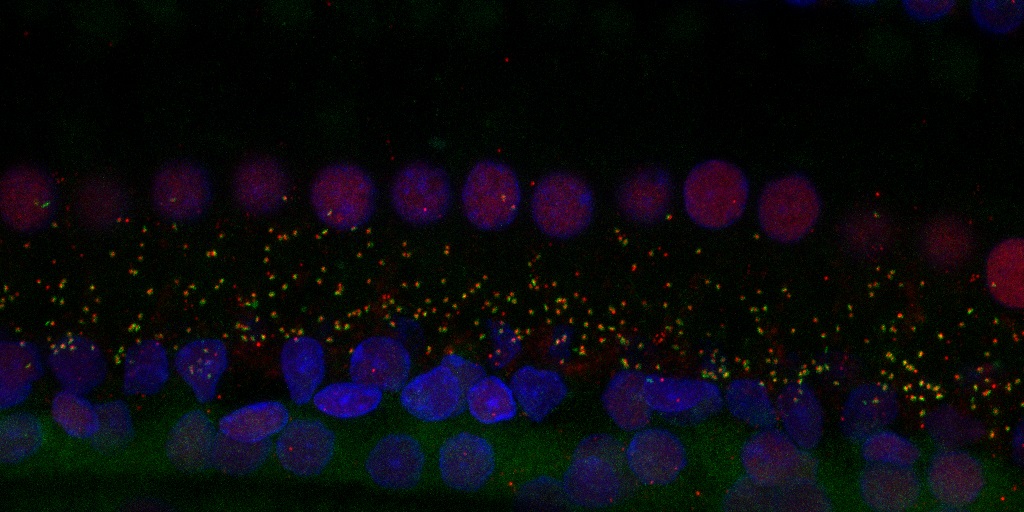Hearing Sciences
Main Content
Translational Auditory Physiology Lab
The Spankovich lab

Immunostaining of inner hair cell synapses (performed by Alberto Arteaga, MD, PGY1)
The Translational Auditory Physiology (TAP) lab in the Department of Otolaryngology - Head and Neck Surgery is interested in the study of the pathophysiology of acquired forms of hearing loss and tinnitus and identifying novel approaches for prevention. The TAP lab includes basic science as well as clinical research, and epidemiological research.
- Basic science: Noise and age can lead to mechanical and metabolic disruptions that can induce sensory and neural pathology to the auditory system. Recently, the previously accepted effects of noise and influence on aging have undergone significant scrutiny. Specifically, work has demonstrated that the synapse between the inner hair cell and the afferent neural fibers of the auditory nerve may have enhanced susceptibility for primary damage prior to that of the outer and inner hair cells of the cochlea. This synaptic pathology has been implicated compromised signal detection in noise, tinnitus, and sound sensitivity. We previously demonstrated that temporary threshold shift creating synaptopathy can influence signal detection in noise Lobarinas et al. 2017). We are currently examining the effects of repeated temporary threshold shift on cochlear and neural responses as well as the influence on behavioral tasks such as signal detection in noise and gap detection. A second line of research is focused on prevention of drug-induced hearing loss. Cisplatin and aminoglycoside antibiotics are two commonly used drugs with substantial ototoxicity. Currently, numerous agents are being explored as co-administered drugs to prevent damage to the inner ear. The limitation of these otoprotective agents is the potential for diminished efficacy of the therapeutic aspect of the drug with ototoxic properties. We have developed a method applying thermal manipulation via a modified cool vestibular caloric approach. Our findings suggest significant reduction in threshold shift and loss of hair cells in animals receiving cisplatin (Spankovich et al. 2016). We are currently preparing to examine alternative methods of thermal manipulation and addressing parametric and mechanistic questions.
- Clinical research: The TAP lab is in the process of developing translation of basic science work to human populations to explore novel approaches for understanding the pathophysiology of hearing loss, tinnitus, and sound sensitivity and otoprotective strategies. Recently, we have demonstrated that moderate levels of noise exposure experienced by young adults do not show evidence of physiological findings supportive of significant cochlear synaptopathy (Spankovich et al. 2017). In addition, we have shown early evidence of cochlear pathology in young adults with type-1 diabetes revealed by distortion product otoacoustic emission (DPOAE) fine structure.
- Epidemiology: The TAP lab also and uniquely incorporates epidemiological research in our translational approach taking work from animal to human to population. We are currently examining determinants of hearing loss, tinnitus, and balance issues using data from the National Health and Nutrition Examination Survey (NHANES) and the Jackson Heart Study (JHS). Our goal is to better understand modifiable and non-modifiable factors that influence susceptibility to acquired auditory-vestibular pathology.


